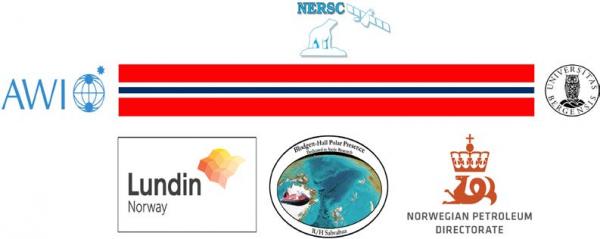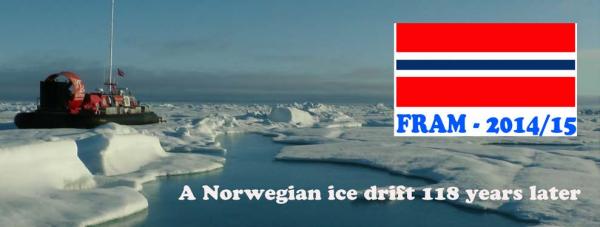
(13 - 19 July 2015)
Ice drift
The ice camp drifted 36 nautical miles (67 km) during the past week (Fig. 1). The drift was oblique to the coast and the nearest point was about 13 nautical miles away from land.
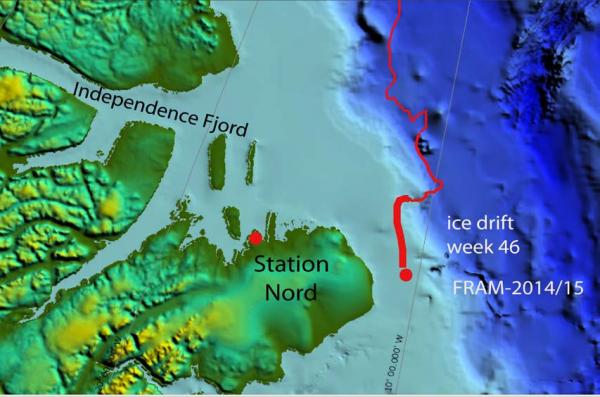
Fig. 1. The drift of FRAM-2014/15 during week 46, 12 - 19 July 2015 ( thick red line).
'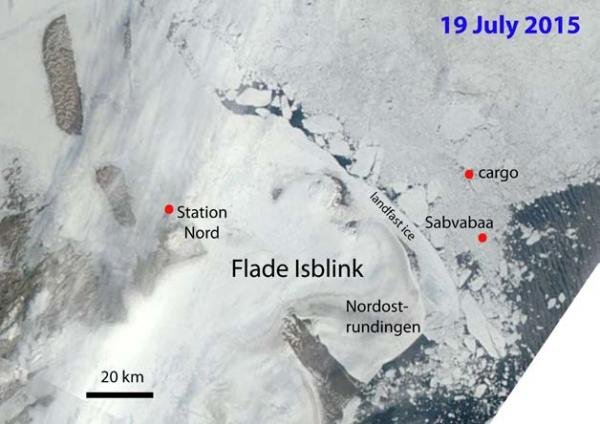
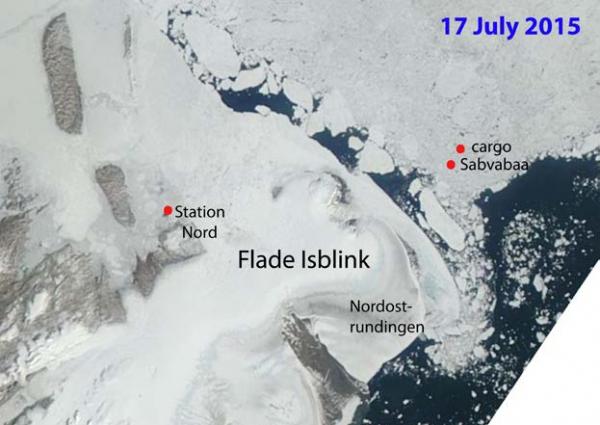
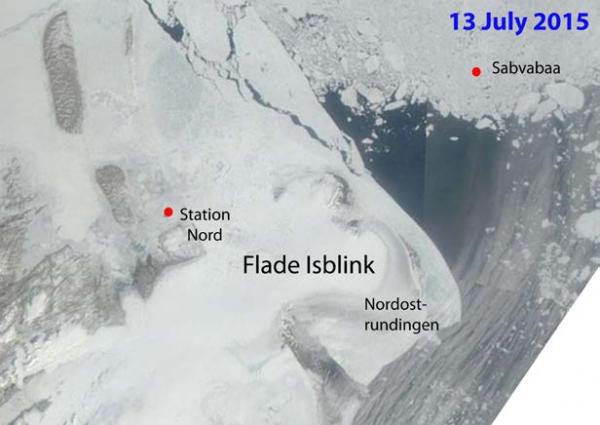
Fig. 2 The ice situation as it developed during the week. Satellite images courtesy of Danish Meterological Institute
Sea ice dynamics
We observed only minor local ice activity during the week, probably driven by the tide for the most part. No ridging occurred. However, the regional ice activity was something very different. As seen from Fig. 2, a large sliver of the landfast ice was severed off about 13 July, disintegrated and the pieces moved fast along the coast towards the south. At the same time, a jet of drifting sea ice created a tongue which turned west around the southeast corner of Nordostrundingen . Formation of the jet implied large lateral variation in drift speed and increased the separation between the hovercraft and the abandoned camp where all the equipment is stored (Fig. 2). At the hovercraft, we measured drift speeds up to 0.5 knot. What forced the jet, a local coastal current or sea ice convergence and extrusion, is not known.
Camp life
The daily routine is dominated by the focus on the dynamics of the ice cover near the ice edge where the sea ice approaches the end of its life cycle. Our location within the ice field has up until now been beyond the reach of any western icebreaker given a reasonable effort, due to the general ice conditions (density of ice ridges and ice thickness). Also hovercraft driving has been impossible with a reasonable consumption of fuel and the need to cut your way through in places. The cargo could have been retrieved by helicopter if available, but there would still the need for the hovercraft to get out. Although we are soon at a point where the distance to land starts to increase, continued patience is the best option. Continued patience also goes along with an emerging mechanical problem of reduced forward thrust. The cause is a bad drive axle bearing. A spare drive axle and bearing assembly is held in Longyearbyen and steps are taken in cooperation with University of Aarhus to get the part out here. Our plan is still to make it to Independence Fjord and work there until pick-up in mid-August.
We are parked on an ice floe about 200 x 300 meter in size, close to an old pressure ridge which runs along its length about 1/3 inboard from the edge. This 1/3 of the floe is higher than the rest of the area and has a free board of 60 centimeter. The large freeboard is because the ice thickness has been doubled by underthrusting (Fig. 3). Sea ice thickens by thermodynamic processes and by mechanical underthrusting. The thickness of new sea ice increases with time by freezing, but the rate of increase slows down exponentially as the insulating effect of the ice cover increases with increasing thickness and snow cover. Most of the sea ice thicker than 2.5 meter is formed by one ice floe underthrusting another. We do not know any figures for the percentage of the sea ice area thickened by mechanical underthrusting, but my guess would be well over 50% in areas with abundant pressure ridges.
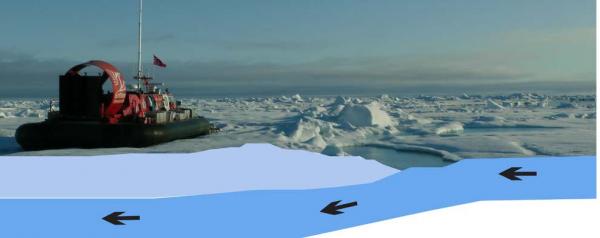
Fig. 3. Underthrusting of ice behind a pressure ridge
We are right now in the zone where the sea ice cover disintegrates completely and melting accelerate dramatically as open ocean conditions are approached (Fig. 2). Although, it may appear dramatic on the satellite image (Fig. 2, 19 July), the surface is still dominated by melt ponds and an occasional small open "hole" of sea water (Fig. 4, lower panel). Not much ice activity has happened on the local level up until now.
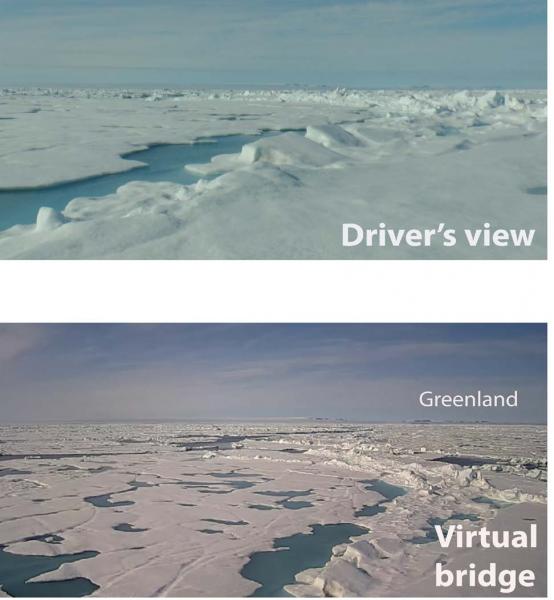
Fig. 4 Comparison between the driver's view (upper) and the view obtained via the camera (lower). Pictures are taken 19 July, compare Fig. 2, lower panel.
Science
With a reduced crew, we have terminated the ice drift science program as a safety measure in order to be unconstrained as the ice edge is approached.
Wild life
A polar bear at a distance and a couple of Ivory gulls are the only wild life observed during the week. I We remain surprised by the few encounters with polar bears in this region.
Life in the High Arctic treats me well.
Yngve Kristoffersen
Daily reports
Monday 13 July
Position: 82° 03.18' N, 11° 05.1' W, temperature 0 °C, air pressure 1020 hPa, wind 12 knots from the S. Ice drift 0.1 towards NNW. Worked on the weekly report
Tuesday 14 July
Position: 82° 00.07' N, 11° 03.7' W, temperature -1 °C, air pressure 1025 hPa, wind 11 knots from the NNW. Ice drift 0.4 knot towards S. Cut a passage through an adjacent pressure ridge to prepare hovercraft access to the nearest lead. A polar bear passed by at a distance of about 100 meter. Washed some clothes.
Wednesday 15 July
Position: 81° 56.40' N, 11° 08.2' W, temperature +1 °C, 1025 hPa, wind 7 knots from the NNW. Ice drift 0.2 knot to the S. Moved the hovercraft over a lead and parked on ice which appeared to be of double thickness from underthrusting. Tried first to park near the edge of the floe to get the echo sounder transducer into the water, but the free board was high (>0.5 m). There was the risk that the hovercraft would slide over the edge and tip sideways into the water, so the attempt was abandoned. The ice drill did not reach through the flow and acquiring bathymetry data had to be abandoned. We have a problem with the propulsion in that when pitch is increased above a certain level, a rattling noise is heard. Past attempts to tighten the drive belt have not alleviated the problem. After being advised to slacken the drive belt between the engine and the propeller, the drive axle was found to have a play which indicates a bad bearing. The hovercraft is drivable, but the problem needs to be rectified without delay. Since we need the engine running for charging of batteries, the drive belt was removed for the time being. We were notified from NERSC that a new web-site for the expedition was put on line (sabvabaa.nersc.no). The site presents updated satellite images of the ice situation around the drift station.
Thursday 16 July
Position: 81° 51.51' N, 11° 10.7' W, temperature +3 °C, air pressure 1027 hPa, wind 6 knots from the N. Ice drift 0.1 knot towards the S. We need to get spare drive axle/bearing from Longyearbyen to here. The possibility of an air drop by a Danish Air Force flight to St. Nord 29 July is investigated.
Friday 17 July
Position: 81° 48.65' N, 11° 05.3' W, temperature +5 °C, pressure 1026 hPa, wind 2 knots from the W. Ice drift 0.2 knot towards the S. Moved the hovercraft a few meter and put lumber across the keels to avoid melting. We are parked parallel to a pressure ridge 4 m away on ice that is likely to have been doubled by underthrusting. Extended observation mast to 13 meter and took pictures in the four main directions. Permission to enter the national park is still pending. A possible air drop by the Danish Air Force will require dispensation as there will be passengers onboard.
Saturday 18 July
Position: 81° 45.1' N, 10° 53.5' W. Temperature +3 °C, air pressure 1026 hPa, wind 2 knot from the W. Ice drift 0.2 knot towards the S. Took pictures in the four main directions. Removed the drive belt for the propeller to minimize load on the bearing. Remaining gasoline for the generator is 15 liter to be held in reserve. The main engine is used for charging batteries from now on.
Sunday 19 July
Position: 81° 36.96' N, 10° 39.2' W, temperature -2 °C, air pressure 1025 hPa, wind 12 knots from the NNW. Ice drift 0.5 knot to the S. Radar distance to land is 13 nautical miles. Took overview pictures in the four main directions. The drive axle assembly in Longyearbyen has been inspected by Audun and found in good order.
